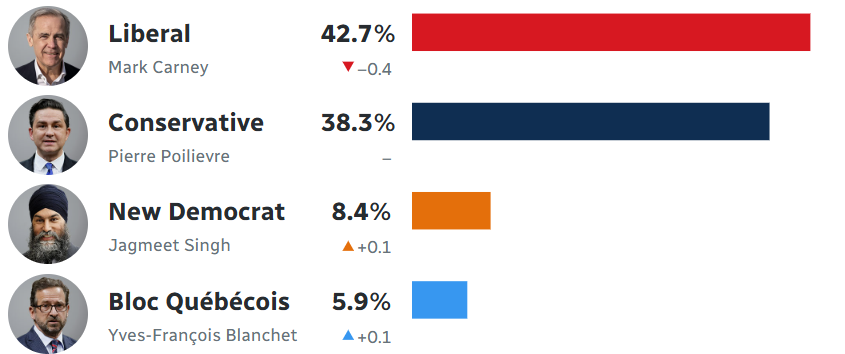Election Writ 4/23: Conservatives aren't budging
The Liberals might be slipping a little, but the Conservatives aren't showing many signs of growth.
The Liberal lead in the polls has shrunk to just over four points in the Poll Tracker average, but this appears to be more of a product of the Liberal vote softening rather than any sign that the Conservatives are on the rise.
Also in today’s newsletter: What to make of the advance turnout figures, plus some tidbits from yesterday’s polls you might have missed. We also follow the leaders again and parse the strategy behind today’s tour stops.
The Liberals have dropped to 42.7% in the Poll Tracker as their lead over the Conservatives slides to 4.4 percentage points. The Conservatives are unchanged at 38.3%, while the NDP is also stable at 8.4%. The Bloc is at 25.7% in Quebec, 14 points back of the Liberals.
The polls published since yesterday’s update (from Mainstreet Research, Nanos Research, Pallas Data, Abacus Data and Léger) do not show tremendous change — or variety. The Liberals lead by between one and six points across these polls, with support ranging from 40% to 44%. The Conservatives are between 37% and 41% in these surveys, with the NDP between 6% and 11%.
These are numbers we’re starting to get used to in this final week of the campaign. The Liberals aren’t around that 45% mark anymore, but are somewhere in the low-40s. The Conservatives are pretty much where they’ve been since Day 1 in the high-30s.
Going beyond the tos-and-fros of the daily trackers, the three guardrail polls published yesterday by Abacus, Pallas and Léger show the Conservatives unmoved. Since they were last in the field (roughly around April 11-15, just before the debates), the Conservatives are either up one point (Pallas and Léger) or down one point (Abacus). In other words, they haven’t budged.

And time is running out for them — especially when you look at the regional results. The Liberals led by between five and 12 points in Ontario across these polls and by between two and nine points in British Columbia. I’ve said it before and I’ll say it again: the Conservatives cannot win if they are trailing in these two provinces.
There has been some chatter that the NDP is doing a little better in the last few days, particularly in British Columbia. I’m not seeing any evidence of that. The Poll Tracker aggregate has the NDP at 13% in B.C., exactly where they were a week ago and the week before that. The Nanos poll this morning was like a dagger to the heart of New Democrats. The party had registered 10.7% and 10.4% nationally in the last two trackers but was down to 7.7% today.
There’s also been some discussion that the Bloc is cutting into the Liberal advantage in Quebec. They are, but we shouldn’t exaggerate the numbers. Since last week, the Poll Tracker has the Bloc up one point in Quebec and the Liberals down three points. While that has shifted a few more seats into the Bloc column (they are projected to win 23, up from 16 just over a week ago) it hasn’t yet put the Liberals in serious danger of dropping into minority territory. Three of the polls added to the aggregate this morning have the Bloc between 24% and 26%, which is hardly a sign of the party catching fire. A handful of surveys have put the Bloc at or north of 30%, so that is something to keep an eye on, but this looks more like a potential Bloc surge rather than a confirmed one.
Advance turnout hits new high, but what does it mean?
Elections Canada reported that 7.3 million people went out to vote over the four days of advance voting, an increase of 25% over advance polling turnout in 2021.
But does it mean that turnout overall will be higher in this election? That I’m not so sure about that.



